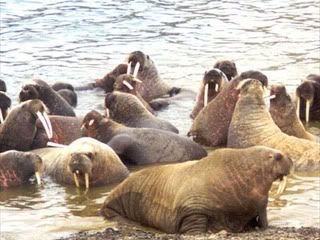
How many more stories of this kind are we going to read about in the coming months?ANCHORAGE, Alaska (AP) -- Thousands of walrus have appeared on Alaska's northwest coast in what conservationists are calling a dramatic consequence of global warming melting the Arctic sea ice.
Alaska's walrus, especially breeding females, in summer and fall are usually found on the Arctic ice pack. But the lowest summer ice cap on record put sea ice far north of the outer continental shelf, the shallow, life-rich shelf of ocean bottom in the Bering and Chukchi seas.
Walrus feed on clams, snails and other bottom dwellers. Given the choice between an ice platform over water beyond their 630-foot diving range or gathering spots on shore, thousands of walrus picked Alaska's rocky beaches.
"It looks to me like animals are shifting their distribution to find prey," said Tim Ragen, executive director of the federal Marine Mammal Commission. "The big question is whether they will be able to find sufficient prey in areas where they are looking."
According to the National Snow and Ice Data Center at the University of Colorado at Boulder, September sea ice was 39 percent below the long-term average from 1979 to 2000. Sea ice cover is in a downward spiral and may have passed the point of no return, with a possible ice-free Arctic Ocean by summer 2030, senior scientist Mark Serreze said.
No comments:
Post a Comment